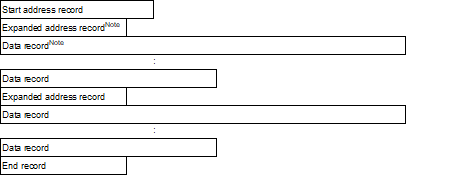3.5.1
Structure of the Intel HEX file
The Intel HEX file (20 bits) consists of four recordsNote: start address record, expanded address record, data record, and end record.
The Intel HEX file (32 bits) consists of six recordsNote: start linear address record, expanded linear start address record, start address record, expanded address record, data record, and end record.
Note | Each record is output in ASCII code. |
The structure and contents of the Intel HEX file are shown below.
Figure 3.1 | Structure of Intel HEX File |
Note | The expanded address record and data record are repeated. |
Each record consists of the following fields.
: XX XXXX XX DD......DD SS NL
(1) (2) (3) (4) (5) (6) (7)
|
|
|
|
|
|
Record mark
|
|
|
Number of bytes
The number of bytes is expressed as 2-digit hexadecimal number of (5).
|
|
|
Location address
|
|
|
Record type
05: Start linear address record
04: Expanded linear address record
03: Start address record
02: Expanded address record
00: Data record
01: End record
|
|
|
Code
Each byte of code is expressed as 2-digit hexadecimal number.
|
|
|
Checksum
This is the 2-digit two's complement value of a result of hexadecimal addition of all bytes in the record except for ":", "SS", and "NL".
|
|
|
Newline (\n)
|
Remark | The location address in the Intel HEX format is 2 bytes (16 bits).
Therefore, only a 64-Kbyte space can be directly specified.
To extend this area, the Intel HEX format adds the 16-bit expanded address so that a space of up to 1 Mbyte (20 bits) can be used.
Specifically, the record type that specifies the 16-bit expanded address is added.
This expanded address is shifted by four bits and added to the location address to express a 20-bit address. |
